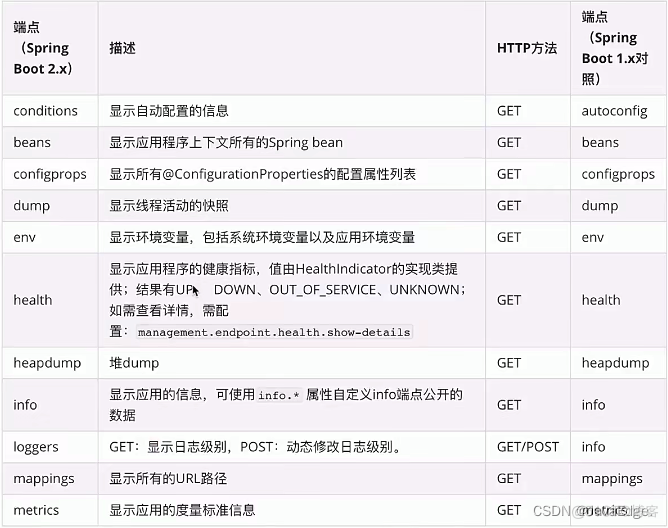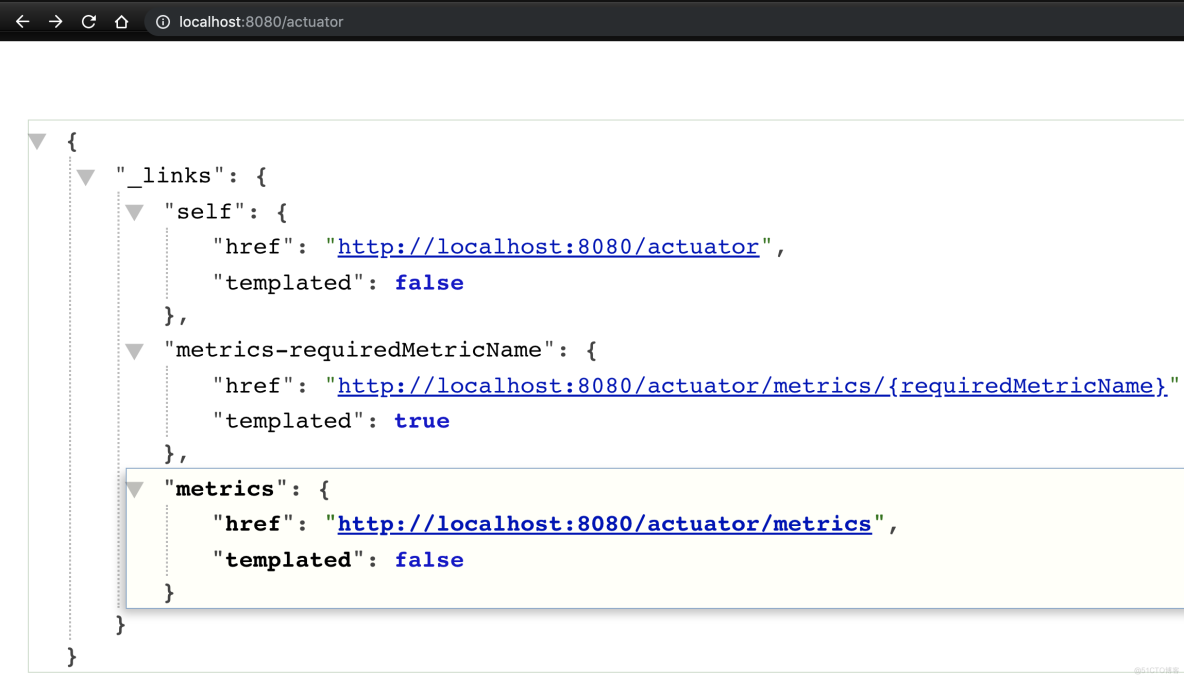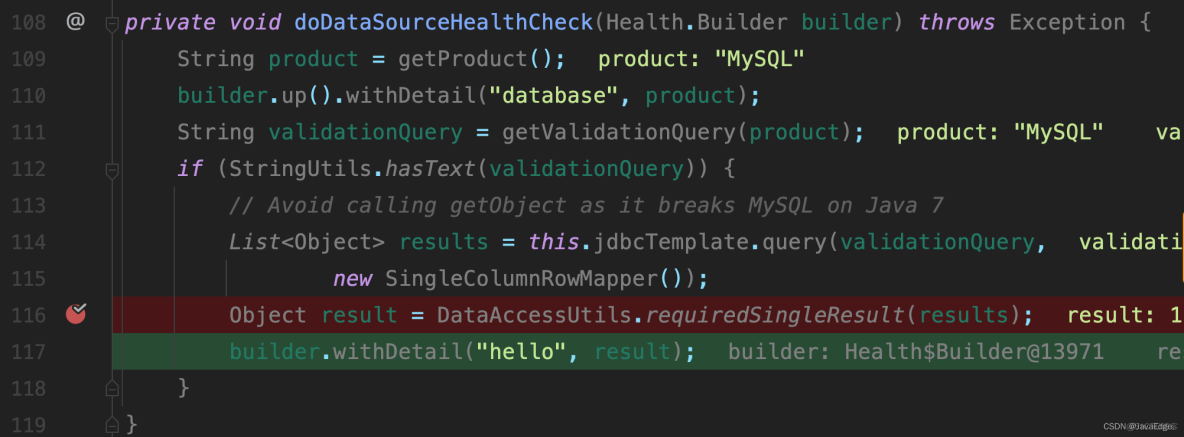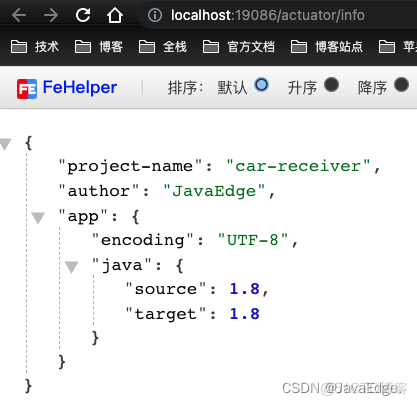1 概述
1.1 整合
添加依赖:
org.springframework.boot
spring-boot-starter-actuator
启动应用,会观察到如下日志:

13:15:17.642 ifp [main] INFO o.s.b.a.e.web.EndpointLinksResolver - Exposing 2 endpoint(s) beneath base path '/actuator'
13:15:17.654 ifp [main] INFO o.s.b.a.e.w.s.WebMvcEndpointHandlerMapping - Mapped "{[/actuator/health],methods=[GET],produces=[application/vnd.spring-boot.actuator.v2+json || application/json]}" onto public java.lang.Object org.springframework.boot.actuate.endpoint.web.servlet.AbstractWebMvcEndpointHandlerMapping$OperationHandler.handle(javax.servlet.http.HttpServletRequest,java.util.Map)
13:15:17.655 ifp [main] INFO o.s.b.a.e.w.s.WebMvcEndpointHandlerMapping - Mapped "{[/actuator/info],methods=[GET],produces=[application/vnd.spring-boot.actuator.v2+json || application/json]}" onto public java.lang.Object org.springframework.boot.actuate.endpoint.web.servlet.AbstractWebMvcEndpointHandlerMapping$OperationHandler.handle(javax.servlet.http.HttpServletRequest,java.util.Map)
13:15:17.656 ifp [main] INFO o.s.b.a.e.w.s.WebMvcEndpointHandlerMapping - Mapped "{[/actuator],methods=[GET],produces=[application/vnd.spring-boot.actuator.v2+json || application/json]}" onto protected java.util.Map> org.springframework.boot.actuate.endpoint.web.servlet.WebMvcEndpointHandlerMapping.links(javax.servlet.http.HttpServletRequest,javax.servlet.http.HttpServletResponse)
打开链接,得到结果:
{
"_links": {
"self": {
"href": "http://localhost:19086/actuator",
"templated": false
},
"health": {
"href": "http://localhost:19086/actuator/health",
"templated": false
},
"info": {
"href": "http://localhost:19086/actuator/info",
"templated": false
}
}
}点击此处:

可见:
http://localhost:19086/actuator/health:
{
"status": "UP"
}1.2 暴露端点
默认打开的只有 health 和 info 端点,其实还支持很多端点:

要展示其他端点,需配置:
SpringBoot支持很多端点,除了默认显示的几个,还可激活暴露所有端点:
management:
endpoints:
web:
exposure:
include: '*'观察日志:

若仅想暴露某端点也可:

具体维度的指标,还得细化,如查看JVM最大内存:

2 健康信息
健康信息可以检查应用的运行状态,它经常被监控软件用来提醒人们生产环境是否存在问题。health端点暴露的默认信息取决于端点是如何被访问的。
- 对于一个非安全,未认证的连接只返回一个简单的’status’信息
- 对一个安全或认证过的连接其他详细信息也会展示
2.1 顶层接口
package org.springframework.boot.actuate.health;
/**
* 这个接口可以通过某种策略来判断程序应用的健康状况
*
* @author Dave Syer
* @see ApplicationHealthIndicator
*/
@FunctionalInterface
public interface HealthIndicator {
/**
* 返回健康状况的指示
* 这个指示可以告诉程序用户或管理员系统的健康程度,以供后续决策和操作。
*/
Health health();
}
Health的数据结构如下:
@JsonInclude(Include.NON_EMPTY)
public final class Health {
private final Status status;
private final Map details;
...
} Spring Boot 内置了很多自动配置的HealthIndicator,当然也能自定义:

2.2 自动配置的HealthIndicators
Spring Boot在合适时候,会自动配置如下HealthIndicator:

内置状态的默认状态映射:

- UP:正常
- DOWN:遇到了问题,不正常
- OUT OF SERVICE:资源未在使用或不该使用
- UNKNOWN:未知
配置下health节点,并重启:
management:
endpoint:
health:
show-details: always可看到对磁盘的监控信息:
http://localhost:19086/actuator/health
{
"status": "UP",
"details": {
"diskSpace": {
"status": "UP",
"details": {
"total": 499963174912,
"free": 22110871552,
"threshold": 10485760
}
},
"db": {
"status": "UP",
"details": {
"database": "MySQL",
"hello": 1
}
}
}
}2.3 执行流程
以 DataSourceHealthIndicator 为例,在这打断点:
@Override
protected void doHealthCheck(Health.Builder builder) throws Exception {
if (this.dataSource == null) {
builder.up().withDetail("database", "unknown");
}
else {
doDataSourceHealthCheck(builder);
}
}刷新 http://localhost:19086/actuator/health,进入断点:

private void doDataSourceHealthCheck(Health.Builder builder) throws Exception {
// ①
String product = getProduct();
// 就开始拼接要输出的信息了
builder.up().withDetail("database", product);
// ②
String validationQuery = getValidationQuery(product);
if (StringUtils.hasText(validationQuery)) {
// Avoid calling getObject as it breaks MySQL on Java 7
List①其实就是进入数据库驱动包,获取到具体的数据库名称:
String product = getProduct();
private String getProduct() {
return this.jdbcTemplate.execute((ConnectionCallback) this::getProduct);
}
private String getProduct(Connection connection) throws SQLException {
return connection.getMetaData().getDatabaseProductName();
} 
②得到:

③得到hello 拼接的结果:

一旦doHealthCheck方法抛异常,就会被catch:

3 应用信息
点击此处,就能进入 info 端点:

应用信息会暴露所有InfoContributor beans收集的各种信息,Spring Boot内置很多自动配置的InfoContributors,也可自定义。
3.1 自动配置的InfoContributor
Spring Boot会在合适的时候自动配置如下InfoContributor:

注 使用management.info.defaults.enabled属性可禁用以上所有InfoContributor。
3.2 自定义应用info信息
通过设置Spring属性info.*,你可以定义info端点暴露的数据。所有在info关键字下的Environment属性都将被自动暴露,例如,你可以将以下配置添加到application.properties:
info:
project-name: car-receiver
author: JavaEdge
app:
encoding: UTF-8
java:
source: 1.8
target: 1.8
这种信息有啥实际用途呢?比如在接收到告警后的业务处理,我们就能根据服务发现组件上面的服务名称,找到对应的/actuator/info,进而找到对应的owner-email配置的值,发给对应微服务的负责人即可。
可在构建时扩展info属性,而非硬编码这些值。假设使用Maven,可按如下配置重写示例:
info.app.encoding=@project.build.sourceEncoding@
info.app.java.source=@java.version@
info.app.java.target=@java.version@3.3 Git提交信息
info端点的另一有用特性,在项目构建完成后发布git源码仓库的状态信息。若GitProperties bean可用,Spring Boot将暴露git.branch,git.commit.id和git.commit.time属性。
若classpath根目录存在git.properties文件,Spring Boot将自动配置GitProperties bean。
使用management.info.git.mode可展示全部git信息(如git.properties的全部内容):
management.info.git.mode=full3.4 构建信息
若BuildProperties bean存在,info端点也会发布你的构建信息。
若classpath下存在META-INF/build-info.properties文件,Spring Boot将自动构建BuildProperties bean。Maven和Gradle都能产生该文件
配置info:

启动观察输出信息:

4 Beans
Bean 端点提供有关应用程序 bean 的信息。
获取 Beans
- /actuator/beans GET 请求
- 响应的结构:
- 结果中可见 SpringBoot 默认的数据源:



5 总结
的确很方便,可是 JSON 形式的,如何更加可视化呢?敬请期待
服务器托管,北京服务器托管,服务器租用 http://www.fwqtg.net
机房租用,北京机房租用,IDC机房托管, http://www.e1idc.net

